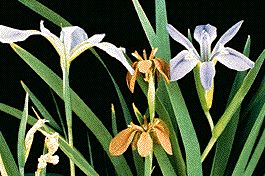Speciation - What is hybrid speciation?

Hybrid speciation: an example
A good example of natural hybrid speciation comes from the wetlands of south Louisiana. The image opposite is of the three parental species in this example. Two of them are Iris fulva , with tawny colored flowers, and I. hexagona , whose flowers are colored in violet with yellow crests. Both species are widespread in streams in southern Louisiana. The third parental species is I. brevicaulis , which is colored like I. hexagona but has a different growth habit; I. hexagona grow up to 4 feet, whereas I. brevicaulis tend to lie flatter on the ground. I. brevicaulis lives in drier habitats such as hardwood forest. Where a bayou (flood) happens to flow into an I brevicaulis habitat, the three species come into near contact: and hybridize.
Natural hybrids are not uncommon, though the rate at which they are formed is low. Hybrids may, to some extent, cross back to the parental species, producing a complicated mix of genotypes in the populations where the species meet. In the 1960s, a new species of iris was detected in the region where hybrids are found, and it was named Iris nelsonii ; it has a morphology, including flower color, and chromosomal complement that shows through repeated back-crossing into I. fulva , rather than from one simple hybridization event.
| Next |



